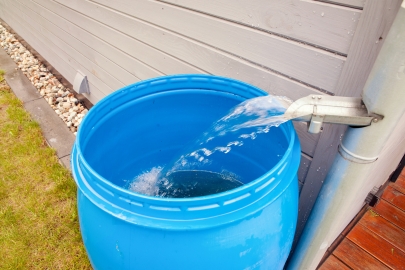Reducing runoff is critical to minimizing the impact our yards and gardens have on nearby lakes and streams. In cities and towns, rain and snowmelt run over impervious surfaces such as rooftops, driveways, streets, and parking lots picking up dirt, salt, fertilizers, pesticides, oil, bacteria, and garbage before running into storm drains. The stormwater in storm drains is not treated, so it can carry those pollutants into the closest lake or stream.
Finding ways to keep stormwater on land and let it soak into the ground can lessen the negative effects on water quality from stormwater and even help replenish groundwater.
Permeable surfaces: Let it soak in

When you are planning changes to your house or lot, think about reducing the size of hard, impermeable surfaces. For areas where hard surfaces are necessary, consider pavers or pavement that lets water through. There are now a variety of permeable pavements on the market that are designed to increase water infiltration into the ground. Ask your contractor or home and garden supply store for water-friendly pavers, or porous pavement or asphalt.
Rain gardens and native plants: Beautiful solutions to water pollution

A rain garden is a popular landscaping choice that allows stormwater to soak into the ground before it runs off. Rain gardens and native plants also:
- Prevent erosion by holding soil in place with their deep roots
- Attract birds and butterflies
- Require little watering and maintenance once established
Rain gardens are bowl-shaped gardens that collect runoff from downspouts or driveways. Plants that tolerate "wet feet" should be planted in the bottom, while plants that need less water are planted on the edges.
- For information about rain gardens, check out the Minnesota Department of Natural Resources or the Cty of Maplewood websites.
- The Blue Thumb Guide to Raingardens leads homeowners through the steps of designing and installing rain gardens in their yards. Blue Thumb also has a Plant Selector Tool. Simply enter in the conditions of your yard—shady or sunny, wet or dry—and the tool will create a list of native plants that will grow well in those conditions.
Rain barrels: Reusing rainwater

Another way to reduce runoff is to capture some of it with rain barrels. Rain barrels also help conserve water. They can be fancy or simple, but the basic structure is to have a barrel at the end of a downspout. The barrel has a spigot or hose that you can use to water your garden or yard. You can find them for sale at home improvement stories or online.
Be sure to disconnect and empty your rain barrels before winter starts, so they don't freeze and crack. To winterize your rain barrel:
- Disconnect the downspout from the rain barrel and re-connect a downspout extension to funnel water away from your foundation.
- Empty the rain barrel.
- Flip the rain barrel upside-down and store it outside, or move it to a garage or basement.
Green roofs: Building smarter
Another way to reduce runoff and the amount of impervious surfaces on your property is with a green roof. A green, or vegetated, roof usually contains a liner, insulation, drainage system, planting medium, and drought-tolerant, low-maintenance plants. Green roofs can reduce the costs associated with roof replacement, energy, stormwater management, the effect of the urban heat island, and improve air quality.
Learn more: Green roof fact sheet
